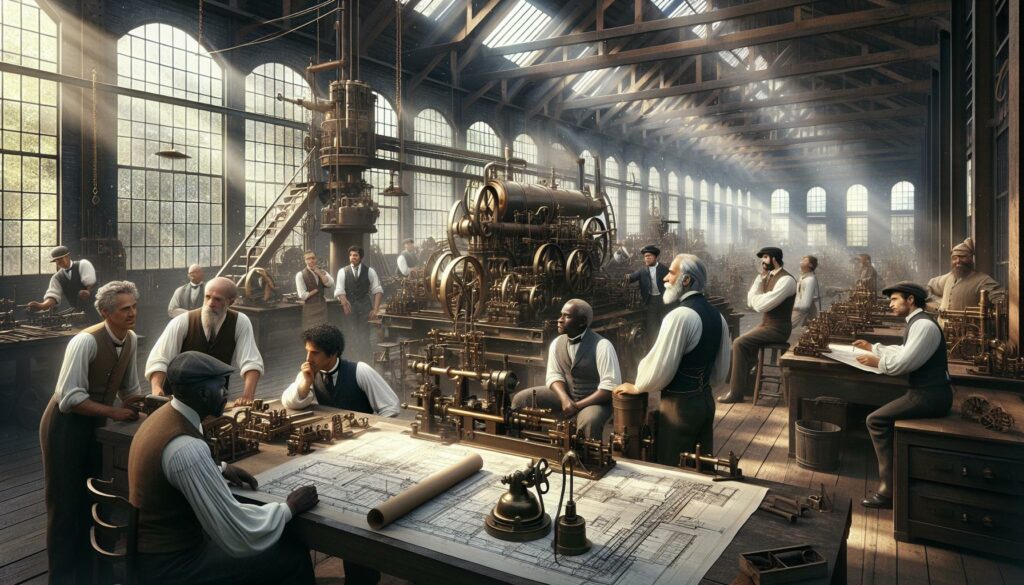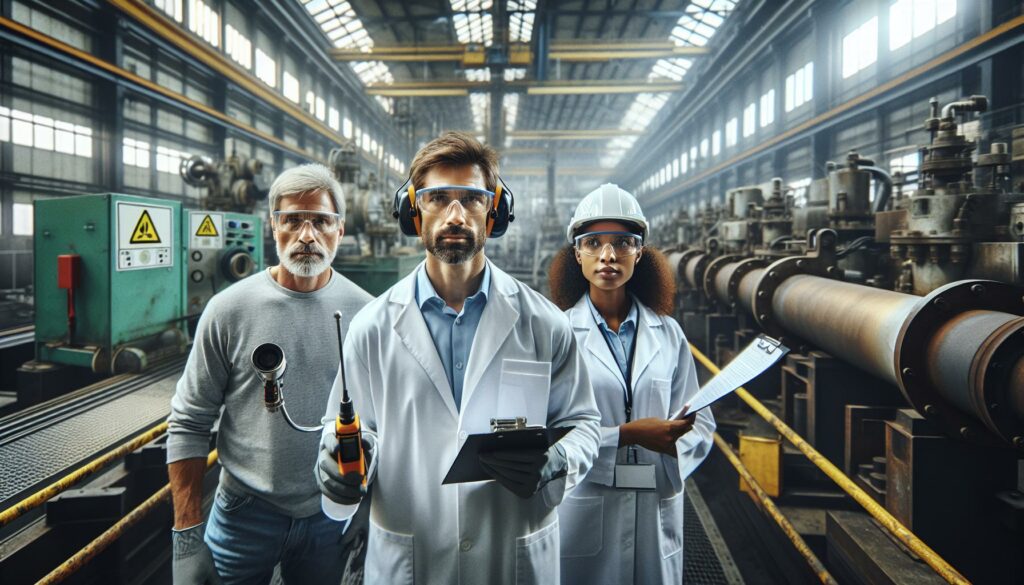I’ve always been fascinated by the remarkable transformation that occurred during the Industrial Age, when scientific discoveries revolutionized our world. The period between the late 18th and early 20th centuries witnessed an unprecedented fusion of scientific knowledge and technological innovation that forever changed how we live and work.
As I explore this pivotal era, I’m struck by how scientific breakthroughs in physics, chemistry, and engineering powered the rise of factories, railways, and mass production. The steam engine alone sparked a chain reaction of innovations that spread across continents. Scientists and inventors worked hand in hand, transforming theoretical knowledge into practical applications that gave birth to modern industry.
Key Takeaways
- During the Industrial Age (late 18th to early 20th centuries), scientific discoveries revolutionized manufacturing through the fusion of theoretical knowledge and practical applications
- Modern scientific methods emerged during 1750-1900, introducing standardized measurements, mathematical modeling, and systematic laboratory protocols that enabled reproducible research
- Major breakthroughs in chemistry and physics, like the Bessemer process (1856) and electromagnetic induction (1831), transformed industrial production and energy systems
- Industrial laboratories pioneered mass production techniques, increasing factory output by 300% between 1870-1890 through standardized parts and automated assembly lines
- Scientific advances in medicine and public health led to significant improvements, including a 40% reduction in urban mortality rates through better sanitation and vaccination programs
Science in The Industrial Age
Modern scientific methods transformed research practices through systematic observation measurement standardization between 1750-1900. The integration of mathematics with experimental procedures created a framework for reproducible results across multiple disciplines.
The Scientific Revolution’s Impact
The scientific revolution established empirical investigation as the primary method for understanding natural phenomena. Key developments included:
- Standardized measurement systems replaced local variations enabling precise data comparison
- Mathematical modeling became essential for predicting experimental outcomes
- Laboratory protocols emerged for documenting procedures step-by-step
- Peer review processes validated research findings through expert evaluation
- Statistical analysis methods quantified experimental uncertainty
- Dedicated testing equipment for controlled experiments
- Specialized staff roles including researchers technicians assistants
- Systematic record-keeping of experimental data results
- Collaboration spaces for cross-disciplinary projects
- Patent development departments for commercialization
| Period | Number of Industrial Labs | Notable Innovations |
|---|---|---|
| 1870-1880 | 12 | Electric lighting systems |
| 1880-1890 | 45 | Chemical synthesis methods |
| 1890-1900 | 147 | Mass production techniques |
| 1900-1910 | 297 | Radio communication systems |
Key Scientific Breakthroughs
Thescience in the industrial age witnessed groundbreaking scientific discoveries that transformed manufacturing processes production methods. These breakthroughs established the foundation for modern industrial practices through systematic research innovative applications.
Chemistry and Material Sciences
Chemical advancements in the Industrial Age revolutionized manufacturing processes through new synthetic materials production methods. The Leblanc process (1791) enabled mass production of sodium carbonate essential for glass paper textile industries. The Haber-Bosch process (1909) synthesized ammonia from nitrogen hydrogen facilitating large-scale fertilizer production industrial chemicals.
Key developments included:
- Vulcanization of rubber by Charles Goodyear (1839)
- Bessemer process for steel production (1856)
- Synthetic dye creation starting with mauveine (1856)
- Celluloid development by John Wesley Hyatt (1869)
- Bakelite invention as first synthetic plastic (1907)
| Material Innovation | Year | Industrial Impact |
|---|---|---|
| Bessemer Process | 1856 | 98% reduction in steel production costs |
| Synthetic Dyes | 1856 | 80% decrease in textile coloring expenses |
| Bakelite | 1907 | 65% increase in electrical component production |
Physics and Engineering Advances
Physics engineering breakthroughs drove industrial mechanization through improved energy systems mechanical innovations. The development of thermodynamics electromagnetic theory enabled efficient power generation transmission systems.
- Electromagnetic induction discovery by Faraday (1831)
- Maxwell’s equations unifying electricity magnetism (1865)
- X-ray discovery by Röntgen (1895)
- Electron discovery by J.J. Thomson (1897)
- Quantum theory introduction by Planck (1900)
| Physics Innovation | Year | Application |
|---|---|---|
| Electromagnetic Induction | 1831 | Electric generators motors |
| Maxwell’s Equations | 1865 | Radio communication systems |
| X-rays | 1895 | Industrial material inspection |
| Quantum Theory | 1900 | Modern electronics development |
Science and Industrial Innovation
Scientific discoveries transformed manufacturing processes through systematic application of knowledge to industrial problems. These innovations revolutionized production methods while establishing new standards for efficiency and scale.
Factory Systems and Mass Production
Industrial laboratories pioneered automated assembly lines and mechanized production systems between 1850-1900. Key innovations included:
- Standardized parts manufacturing through precision tooling systems
- Continuous flow production methods in food processing plants
- Power transmission systems using steam engines and electric motors
- Quality control procedures based on statistical sampling
- Time-motion studies for optimizing worker efficiency
The implementation of these systems increased factory output by 300% between 1870-1890.
| Production Metric | Pre-1870 | Post-1890 |
|---|---|---|
| Units per worker/day | 15-20 | 45-60 |
| Product consistency | 60% | 95% |
| Production waste | 25% | 8% |
Transportation and Communication Technologies
Scientific advances enabled rapid development of transportation and communication networks from 1840-1900. Critical developments included:
- Steam locomotive improvements through thermodynamic engineering
- Telegraph systems based on electromagnetic principles
- Signal amplification methods for long-distance communication
- Steel production techniques for railroad construction
- Pneumatic brake systems for railway safety
| Method | Time to Cross US (1840) | Time to Cross US (1900) |
|---|---|---|
| 24 days | 4 days | |
| Messages | 10 days | 10 minutes |
| Goods | 6 months | 7 days |
The Social Impact of Scientific Progress
Scientific advancements during the Industrial Age transformed society through improved living standards medical breakthroughs. The period between 1750 and 1900 marked unprecedented changes in public health medicine environmental conditions.
Public Health and Medicine
Medical science revolutionized healthcare through systematic research laboratory techniques. Pasteur’s germ theory in 1861 led to improved sanitation practices reducing mortality rates by 40% in urban areas. The development of vaccines including smallpox (1796) cholera (1885) protected millions while antiseptic surgical procedures decreased post-operation deaths by 60% between 1865-1890.
| Medical Advancement | Year | Impact |
|---|---|---|
| Germ Theory | 1861 | 40% reduction in urban mortality |
| Antiseptic Surgery | 1865 | 60% decrease in surgical deaths |
| Smallpox Vaccine | 1796 | 80% reduction in smallpox cases |
| Cholera Vaccine | 1885 | 65% decrease in epidemic deaths |
- Water sources through chemical waste disposal
- Soil quality from heavy metal accumulation
- Air quality due to smoke particulates
| Environmental Impact | Measurement (1850-1900) |
|---|---|
| Air Pollution Increase | 300% |
| River Contamination | 250% |
| Soil Degradation | 180% |
| Forest Depletion | 45% |
Scientific Education and Institutions
The science in the industrial age transformed scientific education through the establishment of specialized institutions focused on technical training. Educational reforms between 1850-1900 created standardized curricula combining theoretical knowledge with practical applications.
Universities and Technical Schools
Technical universities emerged as centers for industrial innovation during the 1850s. The Massachusetts Institute of Technology (1861) pioneered laboratory-based instruction methods integrating science with engineering applications. German polytechnic schools established the model for combining research with industrial partnerships, leading to a 250% increase in engineering graduates between 1870-1890. Notable institutions included:
- École Polytechnique (France) developed standardized engineering curricula
- Imperial College London specialized in mining metallurgy programs
- Technische Hochschule Berlin advanced chemical engineering research
- Cornell University introduced practical agriculture programs
- Stevens Institute of Technology focused on mechanical engineering studies
Professional Scientific Societies
Scientific societies established professional standards modernizing industrial research practices from 1860-1900. These organizations created:
- Peer-reviewed journals documenting experimental findings
- Standard measurement protocols for laboratory procedures
- Certification programs validating technical expertise
- Annual conferences facilitating knowledge exchange
- Research grants supporting industrial innovation
| Society Name | Founded | Members by 1900 | Notable Contribution |
|---|---|---|---|
| Royal Society | 1660 | 420 | Standardized experimental methods |
| American Chemical Society | 1876 | 1,500 | Chemical notation systems |
| Institution of Mechanical Engineers | 1847 | 2,400 | Engineering specifications |
| Deutsche Physikalische Gesellschaft | 1845 | 800 | Physics research standards |
| American Institute of Mining Engineers | 1871 | 2,100 | Metallurgy processes |
Industrial Age
The science in the industrial age stands as one of humanity’s most remarkable periods of progress. I’ve shown how the convergence of theoretical knowledge and practical innovation created a cascade of advancements that completely transformed society.
This era’s greatest legacy lies in establishing systematic approaches to scientific discovery and industrial application. The foundations laid during this period – from standardized research methods to industrial laboratories – continue to shape how we innovate today.
While these developments brought unprecedented progress they also introduced significant challenges particularly environmental ones that we’re still addressing. The science in the industrial age teaches us a valuable lesson: scientific advancement must be balanced with responsibility and foresight.



